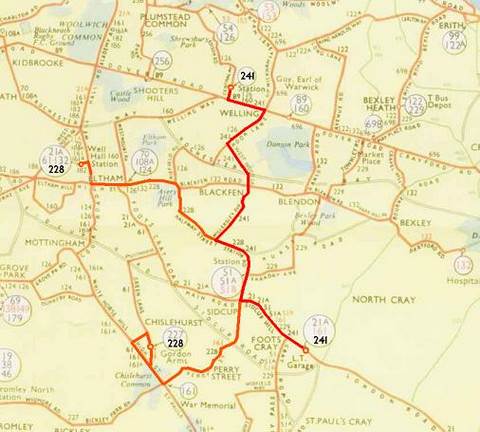Route 241
Page last updated 18 January
2020
The last route to receive brand new RFs in 1953, the 241 was
one of those busy routes targeted to receive double-deckers as soon
as physical restrictions were removed.
In this well known photo,
brand new RF502 running SP7 picks up passengers in Hook Lane,
Welling. The trolleybus in the background is on the
696 from Woolwich.
Photo © Geoff
Morant,
Mike
Morant collection
Dates of RF
operation
1 Mar 53 to 25 Nov 58
(total 5 years 9 months, all crew operation)
Destinations
WELLING STATION and SIDCUP GARAGE
RF Garages
SP Sidcup
Reason for single-deck operation
The
228 and 241 were
single-deck operated due to a low railway bridge at Sidcup
Station. The road was lowered under the bridge in 1958,
allowing both routes to be double-decked in their entirety.
These were the first RF routes to
About five years later, RF466 shows an
intermediate style of blind - still capital letters for the
intermediates, but a 5" high route number rather than the early 7"
number. Indicator 'ears' were fitted in 1956 and the wheel
nut rings and 'dustbin lids' have been painted over. Thank
you to Peter Kennedy who identifies the location as Sidcup
Hill, north-west of the Knoll Road junction. He
adds that virtually none of the original buildings remain, although
the large tree behind the RF survives.
Photo Peter Gomm collection
Route
history
Introduced on 12 Oct 38 between Welling Station and Sidcup
Garage in Foots Cray, the new 241 was originally one-man operated
with 18-seat DA-class Dennis Darts. The route's success soon
led to the need for larger buses, so they were replaced by elderly
29-seat crew-operated 1T1s in January 1939, and these in turn by
37-seat 5Q5s in March 1940.
In May 1939, half of the service Mon-Sat was diverted in Foots
Cray via St Mary Cray and Orpington to Green Street Green, with
Sunday evening journeys added in November 1940. At the start
of 1941, the Mon-Fri evening peak service between Sidcup Station
and Sidcup Garage was supplemented by double-deck workings using
one ST off route 161, becoming an LT from June that year.
These journeys were replaced by an extension to the 161 in January
1943. Increased traffic to the factories along Sevenoaks Way
between St Mary Cray and Orpington led the Foots Cray to Green
Street Green section to be transferred as a bifurcation
of double-deck route 51 in October 1941(becoming new route
51A in December 1942).
As traffic continued to build and frequencies increased, the Q
allocation of 17 (up from 11 in 1941) was supplemented by
petrol-engined 1T1s between 1943 and 1948, at which time another
dozen Qs became available to allow the Ts to be removed. For
their last winter, presumably as the Qs became time-expired, three
of the allocation of 29 Qs were replaced by Ts again.
RF operation arrived in March 1953 (the first 9 starting on 1
March), using the last red RFs to be delivered, and the very last
five were licensed on 25 March. On that day, the
final Qs were withdrawn. The level of passenger demand
can be seen from the peak allocation of 29 buses (replaced by 28
larger RFs) to a route that took 23 minutes from end to
end.
By the time the road was lowered under the bridge at
Sidcup in 1958, allowing the route to be double-decked, the Monday
to Friday allocation dropped from 25 RFs to 15 RTs. The
weekend workings were withdrawn and covered by adjustments to RT
route 51. The 228 and 241 were the first RF routes to
lose their RFs, and the availability of this sizable batch allowed
conversion to RF of the last two routes operating post-war 14T12s,
the
211 and
222, together with the TD-operated
236.
Extended from Welling to Woolwich in May 1963, the 241
replaced the 126 between Welling and Plumstead Common and 54 from
there to Woolwich. The route, still Monday to Friday
only, was shortened in Woolwich and renumbered 51B
in July 1964.
 RF route in detail
RF route in detail, with timing points
SIDCUP GARAGE, Foots Cray High Street, Foots Cray Barley Mow, Sidcup
Hill, Sidcup High Street, Station Road, Sidcup Station, Halfway Street,
Willersley Avenue, The Oval, Wellington Avenue, Blackfen Woodman, Westwood Lane,
Hook Lane, Belle Grove Road, Central Avenue, WELLING STATION
Terminal working at Welling Station: Vaughan Road to stand,
Cleveland Road, Tidford Road to Central Ave; note that replacement
route 51 terminal working operated anti-clockwise to a Vaughan Road
stand.
1955 bus map showing the
Sidcup RF routes 228 and 241.
Map © London Transport
Frequency
| Year |
Mon-Fri |
Sat |
Sun |
| 1941 |
30 mins * |
20-30 mins * |
15 mins |
| 1946 |
5 mins † |
5 mins † |
10-12 mins |
| 1951 |
2-5 mins |
2-5 mins |
6-8 mins |
| 1953 |
2-5 mins |
2-5 mins |
6-8 mins |
* more frequent Sidcup - Welling
† more frequent Sidcup - Blackfen
The route took 22-25 minutes from end to end.
RF allocation
New RFs delivered Mar 53: 464 (ex WG trainer),
479, 488-498, 500-513 plus 3 second-hand (total 29 + 1
spare)
PVR 1953 (Mar): Mon-Fri 29, Sat 22, Sun 12
PVR 1953 (Oct): Mon-Fri 28, Sat 22, Sun 12
PVR 1954 (May): Mon-Fri 28, Sat 20, Sun 11
PVR 1955 (May): Mon-Fri 26, Sat 18, Sun 10
PVR 1957 (Oct): Mon-Fri 26, Sat 18, Sun 9
PVR 1958 (Apr): Mon-Fri 25, Sat 15, Sun 9
On conversion to RT in 1958, Sidcup's RFs were sent to HW for
211, UX for
222
and AR/T for
236.
Re-creation